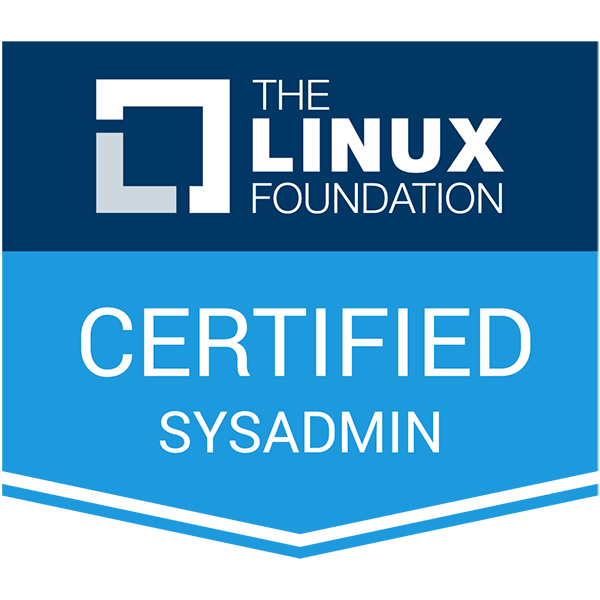LPI Linux Systems Administrator
Online Certification Course from University of South Carolina Aiken
Program Description
This comprehensive program covers LPI Linux essentials as well as instruction and practical application of skills necessary for LPIC-1 certification. The course covers the objectives of both the 101-500 and 101-500 exams and offers an interactive learning experience in system architecture, GNU and UNIX commands, interfaces and desktops, writing scrips, configuring bsic networking and security systems.
Learners who complete this course would have opportunities to be Junior Linux Administrators, Junior Network Administrators, or Junior Linux Database Administrators.
The LPI Linux Essentials certification is a beginner-level exam focusing on developing principles in the IT industry using LPI technology. This certification is ideal for those looking to make a career in Linux systems administration. The LPI 010-160 certification proves that the candidate has the skill set that can help you stand out to hiring managers or your management team.
LPIC-1 certification is the first certification in LPI’s multi-level Linux professional certification program. The LPIC-1 certification validates a candidate's ability to install and configure a computer running Linux and configure basic networking. The LPIC 1 certification consists of two exams:
- 101-500 exam: The 101-500 exam topics are system architecture, Linux installation, and package management; GNU and UNIX command; devices, Linux filesystems, and filesystem Hierarchy Standard.
- 102-500 exam: The LPIC 102-500 exam topics are shells and shell scripting; interfaces and desktops; administrative tasks, essential system services, and networking fundamentals security.
This program covers the following key areas and topics:
- Selecting an Operating System
- Understanding Software Licensing
- Investigating Linux's Principles and Philosophy
- Using Common Linux Programs
- Getting to Know the Command Line
- Managing Hardware
- Managing Files
- Searching, Extracting, and Archiving Data
- Editing Files
- Creating Scripts
- Understanding Basic Security
- Creating Users and Groups
- Setting Ownership and Permissions
- Managing Network Connections
- Exploring Linux Command-Line Tools
- Managing Software and Processes
- Configuring Hardware
- Managing Files
- Booting, Initializing, and Virtualizing Linux
- Configuring the GUI, Localization, and Pricing
- Administering the System
- Configuring Basic Networking
- Writing Scripts
- Securing Your System
As part of this program, Learners will complete the following hands-on labs and activities:
- Exploring the Fedora GUI app
- Managing Processes
- Viewing the Command History
- Getting Help on the Command Line
- Examining the System's CPU
- Examining Hardware Devices
- Viewing Disk Usage
- Finding Hard Drives on a System
- Performing Basic File Management
- Creating a Hard Link
- Finding Files & Exploring a File System
- Using Regular Expressions
- Using the Redirection Operator
- Using the grep and find Commands
- Understanding Compression
- Using Red Hat Package Management Tools
- Displaying Real-Time System Statistics
- Displaying Process Information
- Editing a Text File with nano, vi, and both
- Creating an Advanced Script
- Making Simple Batch Files
- Redirecting the Output
- Reviewing Account Settings
- Managing Users and Groups
- Using the who Command
- Exploring File Permissions
- Changing Permissions of a File
- Finding a Mail Server for a Specified Domain
- Finding Network Information
- Testing Network Connectivity
- Finding Applications That Are Providing TCP Network Services
- Using the type Command
- Displaying the Current Shell on the Ubuntu Distribution
- Using Filters
- Using the paste Command
- Employing the sort Command
- Using Regular Expressions
- Using the cat Command to Concatenate Files
- Using the sed Command to Modify a File's Text
- Investigating RPM App Package Issues
- Using the zypper search Command
- Displaying Process Information
- Sending a Job to the Background
- Exploring Kernel Modules
- Making an Inventory of System Devices
- Creating a Logical Volume
- Identifying System Hardware
- Viewing Disk Usage
- Renaming a Directory Using the mv Command
- Understanding Compression
- Changing the Permissions of a File
- Finding System Files and Placing Files in the Correct Location
- Creating a RAM Disk
- Employing the service Command
- Checking a Display Server
- Viewing the System Locale
- Reviewing Account Settings
- Using usermod to Lock an Account
- Creating a New Group and Adding an Account to a Group
- Managing Users and Groups
- Maintaining the System Time
- Using the timedatectl Command to Set the System Time
- Understanding Network Configuration on CentOS
- Finding the Network Information
- Finding Applications that are Providing TCP Network Services
- Redirecting the Output of a Command
- Running Scripts in Background Mode, in Foreground Mode, and Without a Console
- Writing a Bash Script to View the Password Information for System Users
- Finding the System's Initialization Method
- Managing Services with systemctl
Certification Opportunities
After completing this program, learners will have the option to take the leading national/industry-recognized certification exam(s) essential to entry-level employment in this fast-growing field.
 |
Linux Professional Institute LPIC-1 Certification |
Optional Volunteer Externship Opportunity
Learners who complete this program are eligible to participate in an optional volunteer externship opportunity with a local company/agency/organization whose work aligns with this area of study in order to gain valuable hands-on experience. As learners progress through their eLearning program, an Externship Coordinator will reach out to coordinate placement.
Note: Additional documentation including health records, immunizations, drug-screening, criminal background checks, etc. may be required by the externship facility.

Requirements
- High School Diploma or GED
Program Details
- Mobile-Ready
- All Textbooks
- 24/7 Learner Support
- Certificate of Completion
- Externship Opportunity